Management: This is a comprehensive review of own devising, where I go over a pro and con analysis of the material in an attempt to convince people to watch the show-in-review. Hopefully, in encouraging people in general to watch things I think are interesting, they’ll at least somewhat know what to expect while watching.
Curiously enough, the show takes a relatively short, but also relatively sizable amount of time chronicling the back story of Cadet Eiko Yamano leading up to her last mission, the sort of equivalent to one’s life flashing before one’s eyes.
When it comes to work, she’s an incredibly self-serious individual. She graduated to cadet school a midst the cheers of family and friends in the small neighborhood she grew up in. It’s from those expectations, in part, that’s made her to become as self-serious as she is, dismissive of everything and everyone except in cases related to defeating Gauna and defending Sidonia. She would not have anyone holding her back, and certainly no upstarts making a mockery of her hard work.
And despite her attitude, her convictions, and her history, she gets killed, eaten by the Gauna she’s vowed to kill several times over, in a rather sudden and unceremonious way. Granted, her portrait does get her day on the sterile-looking, minimalistic enclosure that is the war memorial, but only for a day. Her portrait needs to make room for the countless others that’ll follow hers. She’s forgotten afterwards.
This puzzled me at first as to why the show felt it should offer so much of this character other than a mere name and face, which is already pretty generous, if she was slated to die so soon in the series. I was about to chalk it up to emotional manipulation when I realized. How much of this kind of back story could be applied to the named and nameless, face and faceless others in the show that would fall in the line of duty. Others supposedly with dreams they would be sacrificing, and loved ones they would be leaving behind.
And yet nothing more for them is afforded than a day on the wall and a mention grave stones that they existed, in grave plots that don’t even house their bodies. It’s more convenient to offer them to the organic reactor converters instead, if their corpses aren’t already lost to combat or space.
Sidonia moves on because she has to. Sidonia moves on because it’s war.
And so we move on to the show’s main protagonist, Nagate Tanikaze. Found lurking within the bowels of Sidonia, a “seed” ship carrying what is perhaps the last of humanity, a underground array of alleys going left and right, up and down, that he’s pretty much been living in since his birth with his now deceased grandfather. Under his grandfather’s influence, he’s been evidently training in virtual garde combat all his life, gardes being the figurative and literal mecha of Sidonian defense against the Gauna, eldritch-looking space abominations that seem to incorporate aspects of the people it devours, when they decide to devour them. From there, he was brought up by one of the leading figures of Sidonia to become a garde pilot and, eventually, the premiere Knight of Sidonia, the decisive piece needed by Sidonia itself to forever secure her safety.
He’s an impressive figure tactically on the front lines, to be sure, but the show’s also careful not to make him overpowered. In the course of his bout on the surface, he would experience crucial triumphs and devastating travails on a progressively more deadly battlefield, in manners similar to the threat scaling of Neon Genesis Evangelion and the dynamic of desperation and defiance found in Attack on Titan, without the excessive melodrama. His crucial triumphs, in particular, would require his fellow Sidonians to do their parts, often at great sacrifice to themselves, those great sacrifices, of course, not entailing incompetency to artificially enhance protagonist competency. His devastating travails… well, even to recurring to the recurring staff, the show’s not kind to its characters.
In addition to well-paced threat scaling, the show demonstrates this sudden, suffocating, and nearly insufferable dynamic in spades. Singular deaths are compounded complete massacres in the event of a split-second breakdown in composure or chain of command. Overzealous cadets and cool pilots alike are susceptible to panics, enough to render themselves and everyone around them in mortal peril. Those who don’t die might end up too broken in mind or spirit to continue fighting. Inter-team prejudice and intrigue affect morale levels and survival rates. And yet, there are those that rise to the occasion, entering the tentacle lasers of death and the jaws of hell to protect squad and Sidonia alike. The stakes feel real. They feel meaningful.
The show’s sci-fi elements are plenty meaningful too in the way they indirectly or directly contribute to the war effort. Humorously quirky and seemingly exotic reveals of third sexes, human clones, and human photosynthesis, for instance, are tied to Sidonian survival efforts in regards to population growth. And immortality, a thing in the show, is reserved only Sidonia’s leading figures, her best and brightest, as means of optimizing Sidonia’s survival.
It’s rather surreal how much the sci-fi genre lends itself to pushing the bounds of the traditional war narrative. These elements of transhumanism, combined with this constant drive to for the human race to survive, could be compared as akin to the Gauna, who display remarkable capacities of adaptability themselves in the face of their own struggle with humanity. This comparison is apt when referenced to humanity itself. At what lengths is humanity willing to go for its survival? Is it possible that humanity may become something less human as a result? How far can humanity go before it reaches that stage? Or is there even a clear-cut stage at all?
Genetic manipulation’s something that’s rather commonplace among Sidonia’s inhabitants in regards to photosynthesis, though even the more unusual examples of clones or sexes seem to raise very few eyebrows, and those people seem normal otherwise. The conflict, however, of dehumanizing such individuals as mere tools is something that’s still very relevant to the story. Immortality produces a more noticeable effect for some who possess it it, ostensibly to encourage less emotionally colored counsel, but, perhaps, at the detriment of real human concern. Perhaps war itself causes humanity to decline, and all the aforementioned sci-fi’s just one expression of that, the other being plain old egotism and anxiety? Or perhaps war also causes humanity to progress, to as much diversify as well as innovate?
Take the Honoka sister clones for instance. As ethically controversial as the issue of cloning may be, those clones were born, and it’s implied they enjoy life as much as other people in Sidonia do in trying times.
And even the issue of the Gauna in terms of the enemy unknown lends war narrative weight. Human and Gauna have fought each other for centuries without either coming to fully understanding why, and when where war’s concerned, attempts at full understanding by one warring faction of another, especially in the cases of survival and significant communication barriers, are not readily encouraged. And so the Gauna are just readily classified as evil, which is understandable. To match the seemingly single-minded threat of the Gauna requires society working together collectively almost as a single-celled organism, in complete and efficient control of its body. Captured and observed samples of living Gauna question the irrational aggression that’s supposedly endemic to Gauna. Sidonia’s anti-war movement suggests that such a war’s the result of a security dilemma, and that only through Sidonia’s disarmament of anti-Gauna weaponry can bring peace, as only then, they believe, would the Gauna feel safe enough to leave them alone.
I’m probably more tolerable than most when it comes to the use of CGI, and unless one has millions of dollars… err… hundreds of millions of yen to spend, a production composed entirely of CGI, even when balanced by competent cel shading, is going to suffer in some aspects as opposed to a production that relies squarely on cel animation. Most notably is the lack of richness in regards to facial expressions. In other aspects, it can be spectacular, with Knights of Sidonia in particular featuring incredibly fluid fights that are able to illustrate clawing moments of desperation or just crowning scenes of sheer spectacle-laced grandeur so well.
It’s proved it can compete with the best of cel animation when it comes to animating the distraughtingly surreal.
It also lends the world and the Gauna especially a sort of uncanniness, which is helped by the show’s general and often constrastly dark and bleached color palette and scratched, gritty, tired, or sterile exteriors.
The Gauna, in particular, have a visceral similarity to muscle and innards surrounded by a flesh or tentacle matrix, especially when it decides to mimic the looks of the people its… consumed? Assimilated?
The industrial-look of Sidonia’s interior edifices, in addition to their sheer scale, provides an extra layer of oppressiveness or majesty, depending on the context.
Space itself can look voidless, black and bleak, though it can act as a wonderful palette for some rather colorful shots. And those stars.
As ambitious as its subject matter is, the show lacks its equal in characterization. This isn’t to say the characterizations are majorly flawed in any way. They’re simple and straightforward, rather classically fleshed out for the most part. There isn’t anything wrong with simple and straightforward itself, so long as it doesn’t preclude people from feeling love, joy, fear, or grief or anything that makes them not people, and it can be argued that war tends to make people’s priorities simple and straightforward, but in the midst all of this series’ thematic richness and epic spacial scale, the characters themselves can seem comparatively underwhelming. This, of course, maybe due to the series’ limited amount of broadcast time, but the possible compromise the adapters made was still a heavy one. The audience will likely remember the CGI, the spectacle, the sci-fi, the themes, and maybe even the she-bear (the original creator apparently likes bears) before they’re likely to recall who so and so was.
But in spite of these bumps, the show is as entertaining as it is sobering. It’s as much about the thrill of combat as it is when that thrill goes horribly wrong. And when great sacrifices are unavoidably made to achieve temporary respite from looming destruction, or when everything turns to ashes in one’s mouth, when the outsides of buildings and the insides of helmets are splattered crimson and people shit and piss in their breeches because they’re spooked or dead, Sidonia must move on, for everyone’s sakes.
Sidonia moves on because she has to. Sidonia moves on because it’s war.





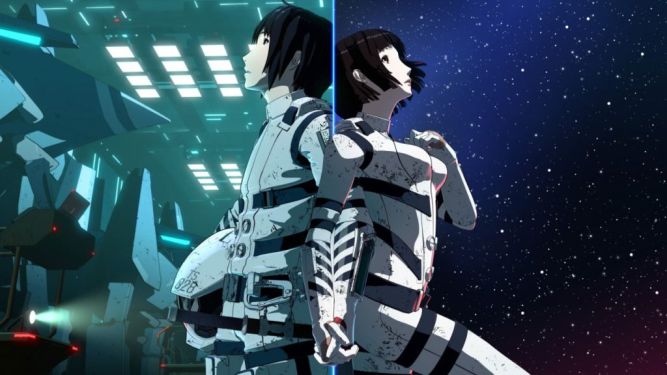
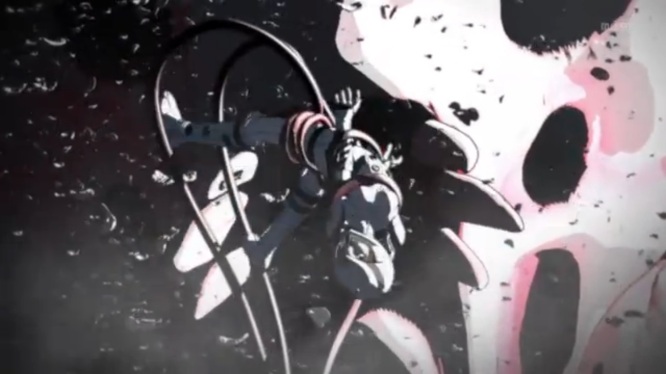


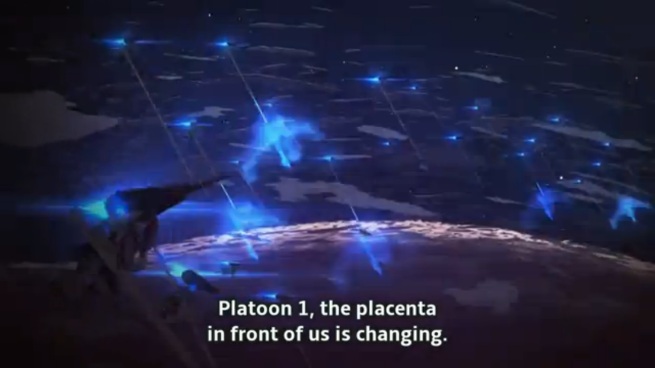

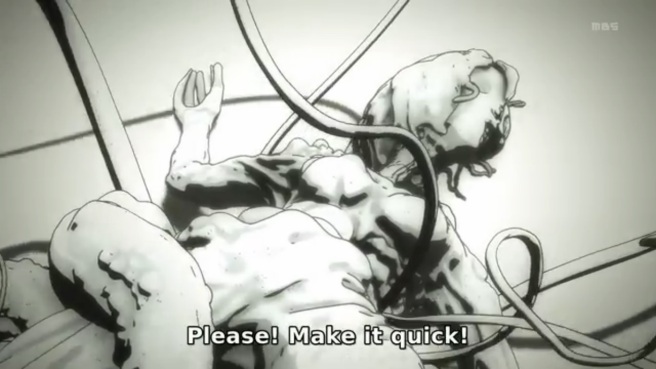

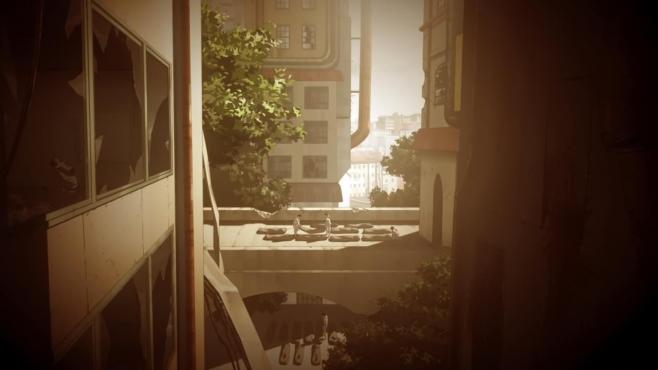


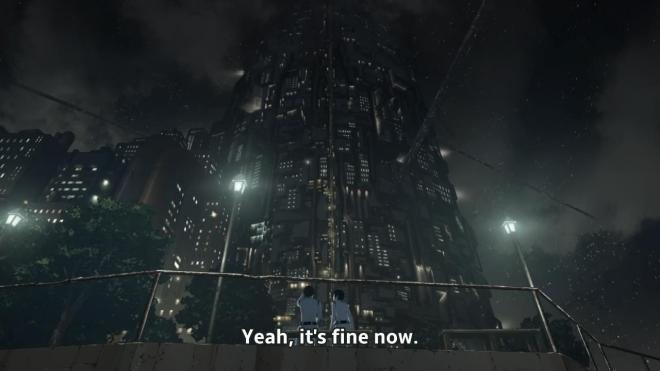


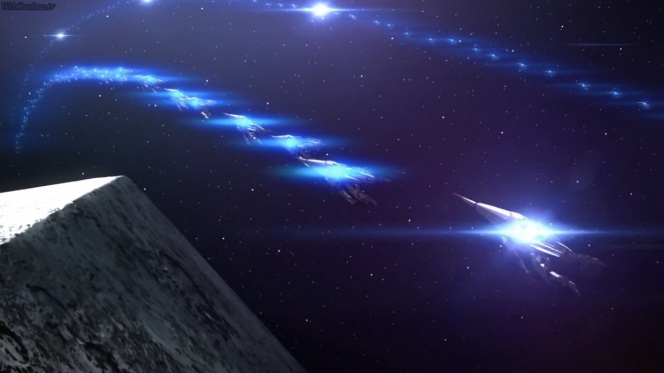
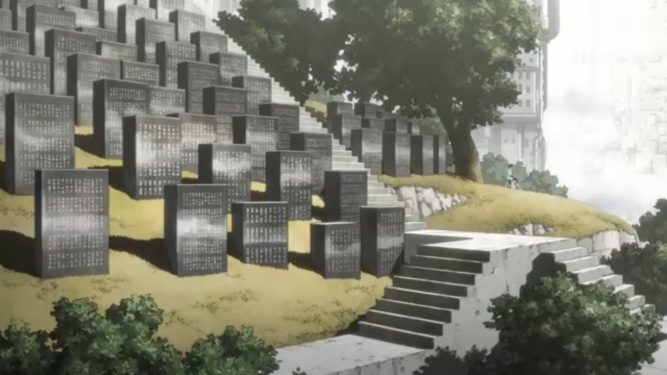
First of all, thank you ZeroReq011 for writing this review. This review is, for all intents and purposes, the exact review I was looking for.
With that said, and I hope you don’t mind, but I’m going to try my best to tear you down. I hope you are ready. High quality calls for high standards from it’s critics.
Before that, though, a quick positive; I really must compliment you on your blog/website. The layout is incredibly good, and makes reading this review much more pleasurable than other websites. The website’s theme seems to, for lack of a better word, “fit” this review. Very appealing to the eye, very simple, yet fundamentally feels like an anime review belongs on it- so very professional. I don’t know if anybody ever told you that, so well done in that regard.
Now *cracks knuckles* where should I begin? Probably from the top. The disclaimer should also include a *minor spoiler* warning. I understand that the text of having a spoiler warning in and of itself is very…unattractive, to say the least. I know this point becomes especially jarring when one asks the critical question of why people are reading reviews when they don’t want any of the plot points violated. However, you owe it to yourself and potential readers to nevertheless give them that fair warning. It’s kind of a slap-across-the-face kind of moment when you have to answer angry readers why you didn’t forewarn them in a review as to why you didn’t have a spoiler warning instead of addressing the fundamental points of the actual review/show and have an engaging discussion it. Do your self the favor, avoid that situation altogether. Trust me, you’d rather have no comments than angry/negative ones.
The review itself is very straightforward. I consider that a good thing. (If anything, what I’m doing right now is nitpicking.) You cover characters, setting, theme, as well as some plot analysis and comparison. This is good, I just disagree with some of your execution of it. Look, I understand it’s much easier to tear down a review than it is to create it, but in the very first paragraph you give us an example of the show’s dramatic and surreal characterization by introducing us to tragic story of Eiko Yamano, who you state is introduced in the first episode as an “self-serious individual…that, despite her attitude, her convictions, and her history, gets killed, eaten by the Gauna she’s vowed to kill several times over, in a rather sudden and unceremonious way…She is forgotten afterwards.”
You ponder the significance. First you think it’s a cheap shot by the show in the case of emotional manipulation, before realizing that this same principle could also be applied to other, faceless characters of the show. You realized this negative is, in fact, a positive.
This is a case-in-point example of why your review does not come across as objective to me .(I’m not saying you, as a reviewer, are not.) I disagree with your point that the show is admirable for this. Instead, I agree with your first conclusion; I just think it’s a cheap shot at emotional manipulation. Why? Because it’s as exactly as you said. They introduce a character, give her aspirations and development in the very first episode, and kill her. That isn’t development. That’s senseless. I mean, really, how is what they did to Eiko Yamano in episode one any different from what they did to Shizuka Hoshijiro in episode six? It is no coincidence the main character’s love interest is the one that ultimately is killed and assimilated to become the primary antagonist.
Let me be clear. What they did to Eiko isn’t a bad thing, necessarily. But we must know and understand that this is meant as an abject attempt at an emotional response. Not only that, but we must also recognize that we’ve seen this exact strategy employed before. Please recall the 2008 TV show Ga Rei Zero. (My avatar on animeshinbun.) It employed both said strategies to an even larger extent than this show did. Episode 1 kills off the entire advertised and introduced cast, and in Episode 9 the love interest of the main character becomes the main antagonist of the show.
To keep things fair. I’ll give a suggestion for what they could have done. If they really wanted give us viewers a shock, here’s an idea: go ahead and kill the main character altogether. (I love doing speculation like this.) No deus ex machina, no tragic love interests, no bullshit. Young prodigy betrayed and killed on mission? Now THAT’s something I’d call a shocker.
As it stands, the show is content to not necessarily be the most innovative war story, but be one of the greatest at what it does within preset conventions. It’s a compromise, to be sure, but it’s a compromise I’m not necessarily content with. It works for a 12 episode show, but they can only keep the actions of the main character believable for so long. Eventually, probably by the end of the next season, the viewer will become somewhat detached to the fate of both the main character and Sidonia. Why be afraid for Sidonia when it’s almost certain the main character will somehow save Sidonia in the end? Despite the cliche nature of the deaths of the early characters; it did keep things uncertain. That’s the beauty of retrospective.
A major reason why, I think, this show is as suspenseful as it is during this season is because it keeps the viewers uncertain. Attack on Titan, to an extent, employs the same idea. Nothing is certain at first. Lots of characters are dying. We aren’t even sure who the main characters are yet, nor the details surrounding the nature of the enemy and how to combat them. The show establishes that the good guys have very nearly lost numerous times. Humanity has already lost earth, they’ve already nearly lost Sidonia once. They lose many of their ace/best best ace pilots in their very first engagements. Put simply, conventions aren’t set yet. Why give up that uncertainty by falling into conventions and situations where we already can guess the outcome? By falling into convention of a hero, it not only makes things predictable but undermines the events earlier on in the story.
It was only when the show established Nagate Tanikaze as the primary hero and character of the show that I realized that the earlier deaths had just been senseless jabs at my emotion.
I suppose that’s just conjecture, though. To be technical, the first inaccuracy in the entire review is in the first two paragraphs. As we clearly see through numerous suggestive moments in the first few episodes, she is clearly not forgotten. In fact, you yourself include an image later on in your very own review of a dream the main character has of Eiko assimilated into the Guana begging for a quick death. The Guana assimilates her, which ultimately means that Eiko’s impact on the story is becoming it’s first unwitting antagonist. Not quite forgotten, as she also serves as a basis to create the story’s first physical and psychological conflict for most of the main characters.
I can keep going, if you like. But I’d prefer to stop here considering I’ve already spent way too much time nitpicking/conjecturing. Again, though I’ve written a lot these are relatively small complaints, for the most part. Really I’m just looking for a nice conversation about it, because I actually just watched this show recently myself.
First of all, thank you so much for responding. I’m glad you enjoyed the review, and I’m also glad you took the time to write me some criticism. I appreciate your words about my blog’s layout.
I see what you mean with spoilers. I’ve already had people complain about that. I’ll do my best in the future to guard for that, even with minor spoilers.
I’ll just say that we have a difference of opinion regarding Yamano and the show’s use of her in general. She’s forgotten by the second episode’ end, but it’s her death which, in fostering the fear of uncertainty, is a microcosm tragedy that lends relatable weight to the macrocosm tragedies that occur shortly later, that grounds those later deaths as more than just a statistic. I think that’s how the execution suggests that whole bit to be, more so than Attack on Titan, which tends to dwell on these deaths more for the sake of how sad it makes the bereaved feel.
I think Hoshijiro was close enough of a main character to create, if not shock, dread, and unlike Yamano, her presence in the narrative despite her passing and despite harem antics remains felt.
Please continue. Part of my desire out of all of this is to have a personal space where intellectual bickering of anime can take place without getting out of hand.
Dread would have been the perfect word for it. I’m glad you understand my complaints are nitpicks for the most part. The argument that Yamano’s death is a microcosm is suitable. Let’s continue.
Though I did nitpick your wording regarding Eiko; you nail your two paragraphs describing the protagonist Nagate Tanikaze. Precise and to the point, I very much agreed with your point that Nagate never felt overpowered in this anime. With Attack on Titan revealing Eren’s hidden/latent powers by Episode 7; this is a very important difference that I didn’t even fully realize until I read it in your review. Nagate is an exceptionally skilled pilot, but he never breaks any rules that the show itself hasn’t set.
The inter-team dynamics is also a very big point that I also never quite considered either. For all the negative tropes that many mecha series (Particularly Gundam) are associated with, Knights of Sidonia avoids nearly all of them. My major complaints are that they didn’t push these inter-team dynamics (jealously, panic, love ect.) even farther. Let us ask ourselves a critical question through this next example. Why still limit ourselves? Or rather, as I would say, what would George Martin do had he handled this situation?
Though the precise nature and intended extent of Norio Kunato’s intentions are never made clear, I would argue he never intended for anyone to be killed in the battle that lead to Shizuka Hoshijiro’s death. Now ask ourselves the critical question. (Could we push this farther?) In many shows like Death Note, if there is any sort of murder it is almost always done by someone stereotypically associated as evil. Having Norio, a calm yet ruthless pilot go to the length of sabotaging a mission critical to safety of Sidonia, but still feeling any sort of guilt with the eventual deaths of pilots, just seems to be a juvenile story decision on the creator’s part. (At least in my opinion.) If not a plothole, it’s at the very least much more distasteful than it could have been.
Same concept goes to the precise nature of the relationship between Shizuka Hoshijiro and Nagate Tanikaze, which remains somewhat unclear to me. Look, I know it’s a bit presumptuous to say that all loving relationships need physical/intimate connection, or that physical/intimate connection means a loving relationships. But despite many romantic hints, they never did confess, kiss, or even (god-forbid) have sex. These questions may seem redundant at first. (Who cares what the precise nature was, wouldn’t you be upset if someone close to you was killed and turned against you?) But keep in mind that there is a fundamental identity crisis at hand here. Is this going to be an adventure story, or a war story? If it’s the latter, I don’t think we can keep placing these artificial restrictions on where the story can and can’t go.
Again, though, retrospective kind of sucks in that regard. It’s much easier to point at a finished product and exclaim “Why didn’t they include..this!” Than make a story of your own. Really, I’m not too concerned about events that already happened in the story insomuch as I am worried these restrictions will limit where the story can go in the future. What’s going to happen when the next romantic interest is introduced? How can the next antagonist have as much of a dramatic appeal as the first two did. (Shizuka Hoshijiro and Eiko Yamano, respectively.)
Which brings us back full circle. This is all possible because, as you said yourself, “well, even to recurring to the recurring staff, the show’s not kind to its characters.” Though I do love the symbolism apparent in your description of Nagate in your third paragraph, which you seem to describe as an epic hero. That’ll be in the next comment, should you still wish to continue. Indeed, though, I love paragraphs six and seven, their implications, as well as the photography that goes along with it. The picture before paragraph six is iconic, to say the least, and really does encapsulate what the show’s story stands for.
Oh yeah, I’d love if the show went all in on its violent emotions. I’d love to see people writhing in agony or related things… I like how disturbingly surreal, for instance, that one… well… instance was where Tanikaze was inadvertently reflecting on Yamano’s death (like, so real it’s unreal, compared to, say, his virtual training simulators)… I wish the show did more with that. I’d mainly like to get a more intimate picture of these individual characters, let alone a more complex one, but the show seems to be concerned with its ideas, more than anything, all the while, a sense of pacing to be kept. War doesn’t wait for people to take their time, after all.
I actually think Kunato’s fairly easy to read, and actually, you inadvertently hit upon what I think he is: juvenile. He’s a person way over his head with his ego, and he deliberately sabotages Tanikaze because of it. I don’t think he meant to get Hoshijiro killed, but all the same, he pinned the public blame for her death and the death of many others on Tanikaze while telling himself over and over that his hands were not soiled with blood. So it’s a nerve-shattering surprise when he is seemingly confronted with it, and I actually love how the show gradually shows this process of his spirit being broken, when all those fake-Hoshijiro’s begin taunting him. He never had to willingly confront his crimes before, but here, he’s forced to, and it breaks him.
Hoshijiro seems like a fairly reserved girl in general, but in my defense of Tanikaze, the guy’s been living underground without any contact with anyone outside of his father. Relationships are still things he’s trying to work with. We might be presumptuous on how we automatically have to think locking two people of the opposite sex in a tin can in space will devolve into a sloppy, lustful mess (the fact they were left in space to potentially die would be something that would, at the very least, control the mood, though their relationship did get notably closer… they hardly knew anything of each other’s lives outside of what was common knowledge) Decisive forwardness might be something that our culture’s more used to. Plus, there’s a certain kind of purity to their feelings towards each other. And I doubt that either of them expected to be permanently separated from each other after. Which, again, leads back to war. War doesn’t make exceptions, War is callous. War isn’t kind.
Yeah, it’s better to tread on light expectations, and it’s not really beneficial to dwell on what could have been, most notably because war won’t care either way.
Continue, please. This is fun, actually.
I just wanted to reiterate that I loved the pictures chosen for this article. I’m not sure if you created them yourself or simply used them. Either way- they’re effective and work extremely well at adding breaks between paragraphs. However, I’d recommend adding captions below some of them to perhaps explain a bit of context for skimmers. Perhaps quotes from the passage itself, as many magazine editions use. Not much of a problem, really. Just a suggestion. As it stands, your choice of pictures in this article is amazing. Well done there.
Once again, I know I already did this in the last paragraph, but Nagate Tanikaze’s description as a character that follows the show’s own rules is very invaluable. It’s a great point, for sure.
Paragraph Seven, following the quick description in Paragraph Six that the show is not kind to it’s characters; picture of the Guana capturing a pilot moments before killing her really does encapsulate a horror many of the pilots do go through when fighting the Guana. Moving on, though, paragraph Seven is absolutely correct that the stakes in the show do feel very surreal and meaningful to the viewer. The single-minded nature of the threat of the Guana also does to serve to create what a utopian society fighting for humanity may look like. That’s another great point you make within your seventh paragraph.
In fact, I’d like to add to that for a moment. Despite the similar nature of the shows, I do feel that this is a critical yet fundamental difference between this and Attack on Titan. In some far-fetched future where the world is invaded by aliens and Humanity is forced to abandon earth, this is indeed something I really could see the world looking like. There is a fundamental layer in this idea that, to me, makes this show much more meaningful than Attack on Titan did. I really did love Attack on Titan as well though.
But again, this just serves to make the stakes of the show feel all that much more real. I totally do agree that there was never a moment during my initial run-through that I didn’t feel suspense and anxious to discover what happens. One of my gripes, then, is that they gave UP that mentality of the initial six episodes in the later half of the series. Granted, the plot still did keep me at the edge of my seat to see whether Nagate Tanikaze would have it in him to defeat the Shizuka Hoshijiro guana clone. He did kill her, which was a “YES!” moment in my book. (But to put it objectively, I do think this was the correct plot decision.) The show stuck to rules it set. Once captured by Guana, there’s no coming back. Knights of Sidonia, like Nagate Tanikaze’s boot we see in episode three stamping out Eiko’s guana; also stamps out the idea there there is going to be a Jesus MMO savior like Kirito in this story.
Despite this, I still question the implicative course (or decision, rather) of having Shizuka Hoshijiro guana clone/placenta display human-like qualities as she did while on the ship. Though I’m glad the plot ultimately revealed her as a simple puppet that spied for Hawk Moth, which gave a finality to the implication that one’s fate with a death and assimilation to a Guana is final. I still can’t say I agree with giving the viewer a picture that differs dramatically to the one fate presented with Eiko Yamano; which was one that depicted an absolutely horrid, grotesque assimilation and subjection of a pilot which, to me, is a fate that seemed much worse than death. Here are two examples of possible implications on the viewer as a result of this decision.
A: You are either already dead when assimilated and not actively suffering, which basically means you are dead and don’t have to worry if you are assimilated. The only thing the Guana will keep is your DNA. This makes the stakes of being captured seem less meaningful.
B: Or you still get to retain human-like qualities, with the possibility of reverting oneself from the Guana. Being saved, rather. Also dramatically lowers the stakes, perhaps even more so, than the previous implication.
Not only that, but let us ask ourselves: at the very least, does this not make Eiko Yamano’s death and assimilation and Norio Kunato’s fight against Hawk Moth less meaningful? I thought it did.
Of course, it’s possible the placenta was just a simple clone of the real Shizuka Hoshijiro used by the Guana. In which case, the “terrible sufferring” still exists but we just don’t see it because it’s on Hawk Moth and not the placenta. It’s also possible the Guana realizes that it can use such puppets/clones to psychologically intimated the Sidonia’s pilots; particularly Nagate Tanikaze. But does this still not seem as well-executed as it could have been? The show could have just as easily done something along the lines of having Nagate be forbidden from interacting with the placenta after he captures it, him disobeying orders, and nearly getting killed by it when he tries to interact with it. (Admittedly however, that is something rather cliche that we see way too often in many zombie stories.) But still, I felt the show could have done more to keep the dark/grotesque nature of the first episodes going.
Back on point, though. In my opinion, it would have been horrible to the dark nature of the plot if a decision was made to let Nagate Tanikaze pull a Kirito and save his love interest (in dramatic fashion) from the Guana. As it stands, I still can’t say I agree with the execution. The show doesn’t actually reveal the fate of the placenta, but I honestly feel that it should have died when Nagate ultimately killed Hawk Moth. I don’t know what the plans are for next season with the placenta, as I haven’t yet read the manga rendition, but that’s just my opinion. Not only that, I think the show should have showed it dying in an absolute horrid fashion. Screeching and/or melting like the monster this show leads us to believe it is. Stamped out, just like Eiko Yamano. Yes, it is in my opinion that would have been more appropriate.
At the very least, it would have made Nagate seem like that much more of a legitimate “epic” and “badass” hero. Up until that point, the story still depicts him as rather weak despite being Sidonia’s best pilots. I disagreed with the show showing/having Hawk Moth hint at happiness that Nagate was finally able to defeat it. It implies some sort of free will, though I won’t theologically argue against it. It’s possible she was being tortured, and was able to break through that one sign of happiness at being defeated by Nagate. I’m not certain, myself, of that one.
But yes, I do feel that having the placenta around only detracted from the emotional impact of Nagate’s realization that Shizuka Hoshijiro is not coming back and finally defeating Hawk Moth. I criticize the show’s fundamental lack of consistency in that regard. But, to bring it full circle, you describe the entire idea perfectly in your seventh paragraph.
“Overzealous cadets and cool pilots alike are susceptible to panics, enough to render themselves and everyone around them in mortal peril. Those who don’t die might end up too broken in mind or spirit to continue fighting. Inter-team prejudice and intrigue affect morale levels and survival rates. And yet, there are those that rise to the occasion, entering the tentacle lasers of death and the jaws of hell to protect squad and Sidonia alike. The stakes feel real. They feel meaningful.”
It makes me wonder how the show can continue to advance the plot in such a way that the Guana threat CONTINUES to feel this revenant going into the story’s future. As always, it’s not the past events nearly as much as the potential future events that have me deliberate like this.
In regards to the pictures, it’s a combination of both. Takes me quite a while to gather them, actually.
I think it’s a matter of thematic transition, characterizing the Gauna as lovecraftian monsters to something possibly more akin to people, and I think the Sidonian higher ups are wise in exploring that possibility, and the show itself is ambitious for associating the Gauna with barbarism. There’s only so much of that type terror one can exert upon the audience before said audience starts to feel numb or exhausted from it. Attack on Titan’s kind of hit that problem. Barbarism may be connotated with modifiers such as cruel ,savage, and uncivilized, but, strictly speaking, it was originally meant as a catch-all term for foreigners. Part of the reason why Sidonia takes such an aggressive stance towards the Gauna are because she believes it’s much too high a risk to give the Gauna the benefit of the doubt without any solid assurance that the Gauna won’t exterminate them when they’ve let their guards that. That’s because they are barbarians, and they’ll always stay barbarians until there’s some way to establish some dialogue between them, which before, was impossible. But if there’s a possibility the war can end that way, it’s worth considering when the opportunity presents itself, and there are suggestions of that. The Gauna obviously carry some form of intelligence, enough to take uncanny human forms and adopt human speech to intimidate human pilots. Said opportunity requires communication, and communication’s something that was beyond these two races… Perhaps until Ena-Hoshijiro and Nagate Tanikaze. Ena-Hoshijiro, the Gauna, only responded to Nagate Tanikaze, the human. Perhaps something could be made from that that could sow the seeds of future peace.
In regards to whether or not the pilots are still alive once they are absorbed… I’m inclined to say they’re gone and dead, but I think that in itself is an interesting conflict. They may be realistically out of the picture, and the pilots might tell themselves that, but there are moments, usually moments of extreme stress, where a raw nerve is struck, despite one’s better judgment.
I don’t quite know what to make of Ena-Hoshijiro. The show seems to give a conflicting images of her, of whether or not she’s merely an extension or if she truly has a mind of her own, which I feel is something praiseworthy. The inconsistency seems deliberate. The show pulls the audience both ways, and sets up a later interesting conflict. It’s a good transition to what I feel the sequel will end up covering in depth, of whether or not there is some way to get along with the Gauna.
Of course, that’s an excellent point you made about the difficulties of moving on from personal loss, and obviously, Tanikaze’s going to be devastated when he founds out Ena-Hoshijiro’s missing. However, if you’ve ever checked out the Japanese rips of the show in addition to watching the Netflix original ones, you’ll see that this is probably not the last you’ll see of the Crimson Hawkmoth.
I’ll keep your captions suggestion under advisement.